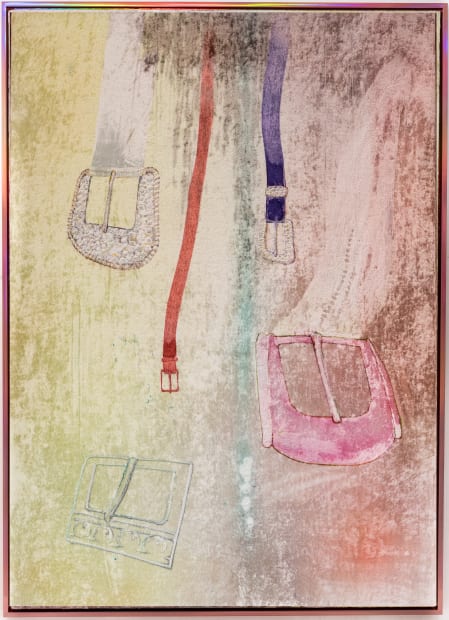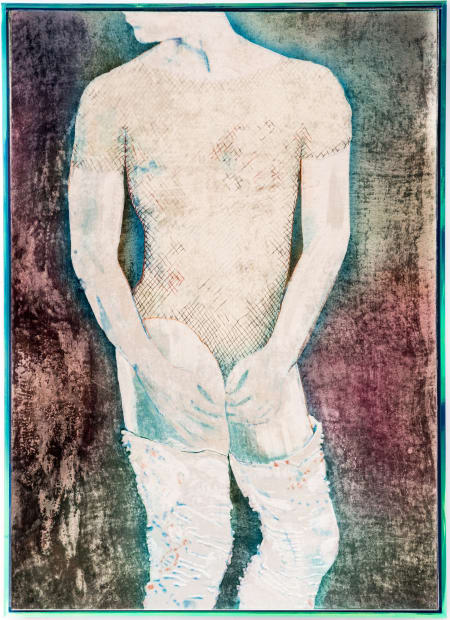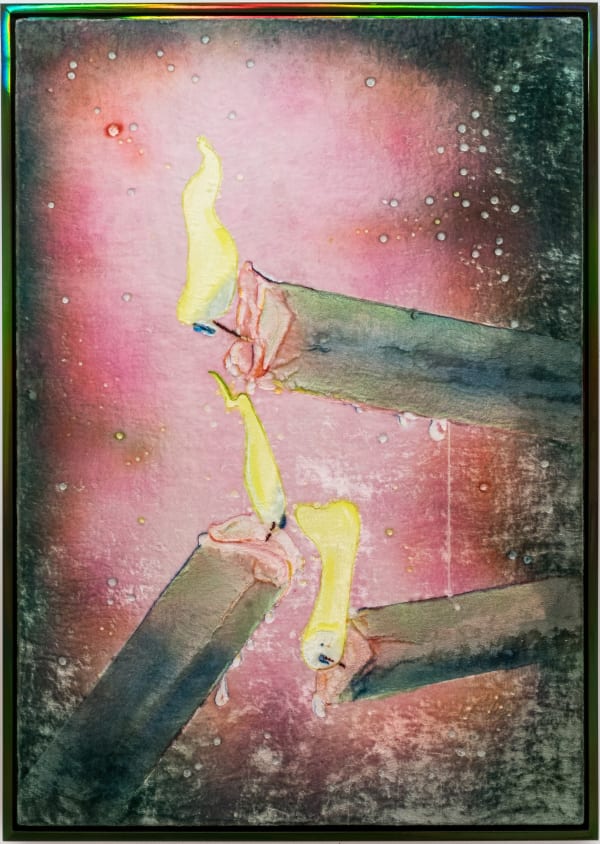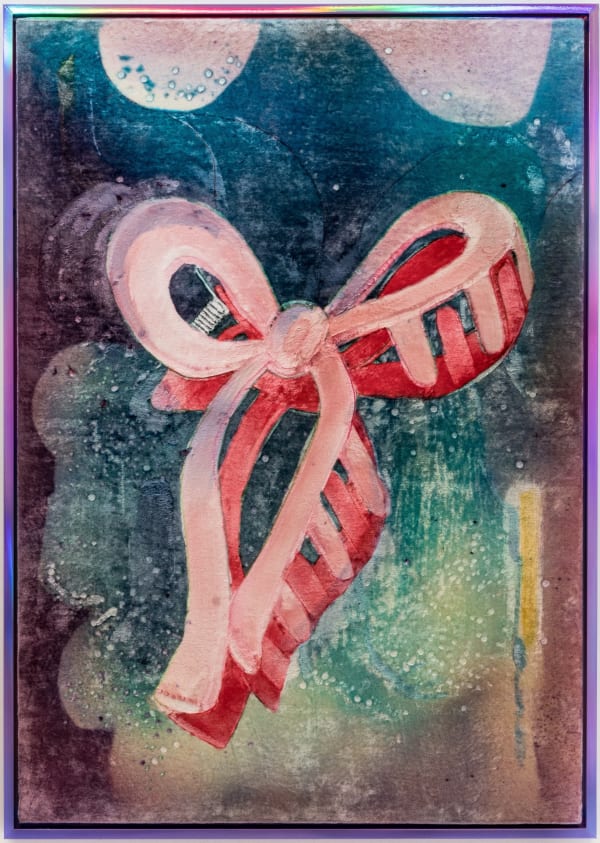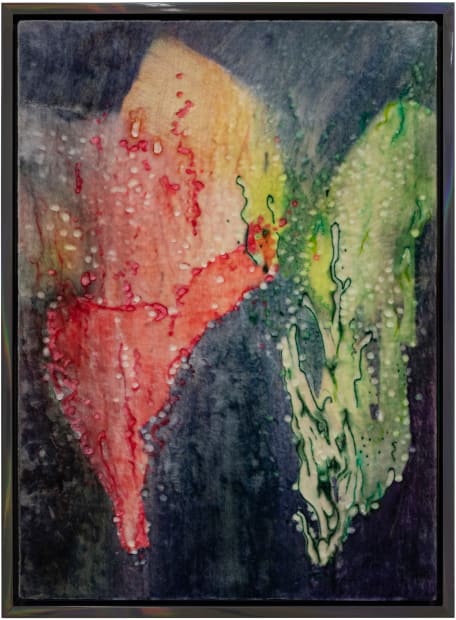-
Galerie Peter Kilchmann is pleased to present Personal Effects, a solo exhibition of new paintings by New York– based artist Travis Boyer (b. 1979, Fort Worth, Texas, US) and his first solo exhibition in Switzerland. Executed with dyes on silk velvet, Boyer’s works explore how surfaces accrue meaning, inviting reflection on ornament, cultural memory, and queer embodiment.
-
-
Rich in texture and layered with historical references, the works in Personal Effects transform the decorative into the political and the sentimental into the critical. Through a fusion of self-styling, camp, and material sophistication, Boyer articulates a painterly language that embraces excess, ambiguity, and seduction.Velvet is both medium and metaphor in Boyer’s work. As a substrate, it carries a unique material history: once a fabric of aristocratic luxury, later a marker of bourgeois domesticity and, by the 1970s, a fabric of countercultural kitsch. In Boyer’s hands, this complex lineage is neither rejected nor idealized. He paints with a category of dyes known as protein dyes, used for animal substrates such as silk, wool, and hair, exploiting the material’s capacity for optical depth. Painting on both the reverse and front sides of the fabric, he allows pigments to bleed through or be pressed in. For this furry surface, he uses tools from beauty culture—steamers, atomizers, and industrial hairdryers—to sculpt and manipulate shifting planes of color and texture.These paintings refuse to be flattened, literally or metaphorically. As the velvet’s pile refracts light, the images emerge and recede, shimmer and dissolve. There is no single point of view; the viewer must move, look closely, and engage with all visual perceptions. In an age dominated by slick digital images and scrollable content, Boyer’s work demands embodied looking. His surfaces are not passive grounds but performative, unstable, and assertive.The motifs that populate Personal Effects are drawn from an archive of adornment: false eyelashes, thigh-high boots, jewelry, rhinestone belts, feathers, and fragments of costumes. They are objects that signify identity, aspiration, and transformation.
-

-

-
Some works function as still lifes: Green Carnation Pink Dragonfruit evokes Oscar Wilde’s coded floral hanky code of queerness, while Brooches Click Clack presents a constellation of baubles that seem to jostle and whisper among themselves.
-
-

-

-

-

-

-
Others, such as Born to Do This, and Boots Continuum, depict adorned torsos in states of becoming. These figures are not portraits, but embodied ideas - costumed, faceless, and full of presence.
-

-
-

-

-
Other works explore relationships and ritual through atmospheric metaphor. Third Keeps Taut, with its trio of burning candles, alludes to intimacy and triangulation, while Suggestion Diabolique hints at seduction and spectacle through its play of light and shadow. Feel the Night is Made of Rocks presents paired crystals as emblems of mirrored longing, echoing the doubled dynamics of queer kinship. In these pieces, objects serve not as props but as witnesses, accumulating memory, storing desire, and animating the silent performances of daily survival.
-
-
-
-
Writer Elyssa Goodman describes Boyer’s method as one of “self-seduction,” a practice of convincing oneself to believe in the possibility of expression through materials that are unruly, feminized, and historically devalued. Like his grandmother Virginia Odette Canada, who the artist recalls ritualistically dying her eyelashes while watching Oprah, Boyer approaches beauty as both labor and play. Adornment becomes a technology of the self, a form of armor and celebration.A central reference in Personal Effects, as noted by art historian Susanna Cole, is the figure of Pierrot, the tragicomic clown of the Commedia dell’Arte. From Watteau’s Gilles to Picasso’s blue-period acrobats, Pierrot has served as a blank slate onto which artists project melancholia, marginality, and modernist dislocation. Boyer, however, queers the figure through what theorist José Esteban Muñoz calls disidentification: a process by which minoritarian subjects reclaim dominant codes and recode them toward liberation. In Boyer’s reimagination, Pierrot is not the butt of the joke but the center of the stage - confident, adorned, and conspiratorial.While Boyer is grounded in contemporary queer culture, his work draws equally from art historical references, particularly the Rococo. Like Fragonard and Boucher, he collapses distinctions between painting and the decorative arts. Works like Bow Bound and Nuit d’Amour echo the sensuous, pastel-toned indulgence of Rococo interiors, but they do so with a knowing wink. There is a deliberate exaggeration, an embrace of what Susan Sontag called the “democratic spirit of camp.”
-
Yet Boyer is not interested in irony for its own sake. Rather, his work reclaims surface from the Modernist suspicion that deemed ornament as excess and kitsch as cultural failure. He operates in a lineage that includes Joyce Pensato, Ulrike Müller, and K8 Hardy - artists who have queered the legacy of Abstract Expressionism through humor, bodily reference, and feminist rage. Where Clement Greenberg demanded flatness and disinterest, Boyer offers pile, sparkle, and intimacy.As critic Thomas Love observes, Boyer’s velvet paintings subvert the binary of surface and depth. They demonstrate that surfaces, especially those that are tactile, adorned, and performative, can carry profound meaning. Boyer’s paintings may appear decorative, but their demands are conceptual. They propose an expanded field of painting that includes the politics of looking, the histories of gendered labor, and the poetics of transformation.Throughout the exhibition, Boyer constructs a constellation of works that navigate between still life and staged performance. As in all of his paintings, these are not just representations, but rehearsals of possible selves. In this way, Personal Effects becomes more than an exhibition but rather a stage. Boyer’s velvet panels do not merely depict; they perform. They shimmer with accumulated meaning, drawing on personal memory and shared cultural codes. Boyer’s work celebrates the power of self-fashioning as both survival and resistance, and creates complex, glamorous narratives about seduction.
-

-

-
-

-
-
For further informations, please contact: inquiries@peterkilchmann.com
Galerie Peter Kilchmann
Rämistrasse 33, Zurich
, 14 June - 25 July 2025Be the first to know updates about Galerie Peter Kilchmann
* denotes required fields
We will process the personal data you have supplied to communicate with you in accordance with our Privacy Policy. You can unsubscribe or change your preferences at any time by clicking the link in our emails.
